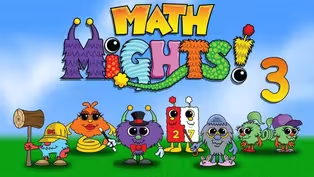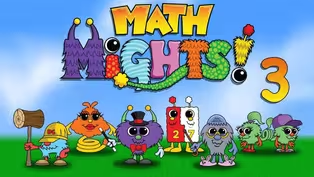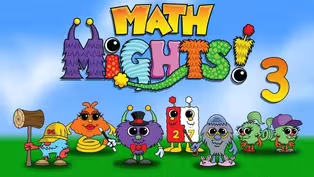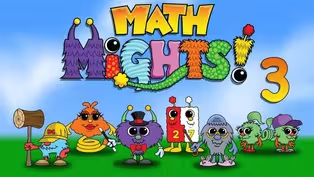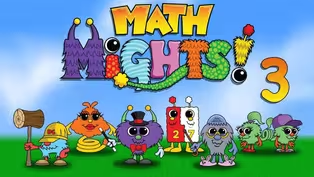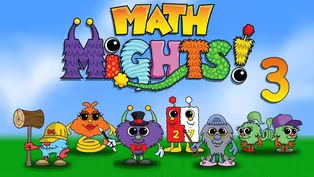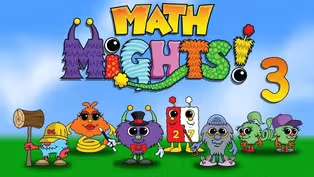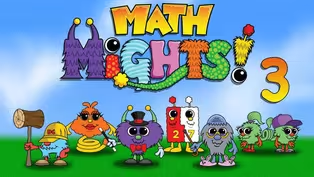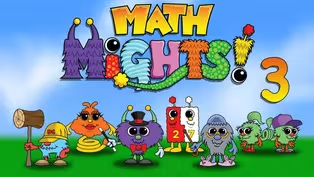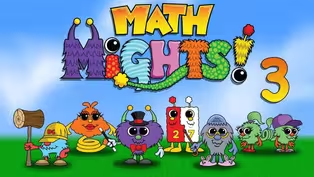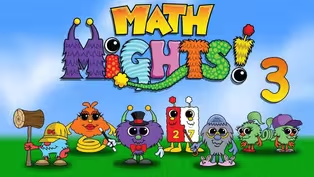Math Mights
Multiply Teen Numbers with Larger Groups
Season 2 Episode 218 | 15m 59sVideo has Closed Captions
Join Mrs. Askew for a Number talk with 2 Math Might Friends!
Join Mrs. Askew for a Number talk with 2 Math Might Friends! Then let's solve some problems with equal groups that have larger numbers!
Problems playing video? | Closed Captioning Feedback
Problems playing video? | Closed Captioning Feedback
Math Mights is a local public television program presented by Detroit PBS
Math Mights
Multiply Teen Numbers with Larger Groups
Season 2 Episode 218 | 15m 59sVideo has Closed Captions
Join Mrs. Askew for a Number talk with 2 Math Might Friends! Then let's solve some problems with equal groups that have larger numbers!
Problems playing video? | Closed Captioning Feedback
How to Watch Math Mights
Math Mights is available to stream on pbs.org and the free PBS App, available on iPhone, Apple TV, Android TV, Android smartphones, Amazon Fire TV, Amazon Fire Tablet, Roku, Samsung Smart TV, and Vizio.
Providing Support for PBS.org
Learn Moreabout PBS online sponsorshipMore from This Collection
Video has Closed Captions
Join Ms. Askew for a tricky multi-step word problem with Professor Barble! (15m 59s)
Build Fraction from Unit Fractions
Video has Closed Captions
Join Ms. Askew for another multi-step word problem with Professor Barble! (15m 59s)
Video has Closed Captions
Join Ms. Askew for a division word problem with her friend Professor Barble. (15m 59s)
Video has Closed Captions
Join Ms. Askew for a division word problem with her friend Professor Barble. (16m)
Video has Closed Captions
Join Ms. Askew and Professor Barble to do a visual model with a word problem. (15m 59s)
Dividing with even larger numbers
Video has Closed Captions
Join Ms. Askew and Professor Barble to do a visual model with multiplication. (15m 59s)
Video has Closed Captions
Join Ms. Askew and Professor Barble to see if you can match visual models to word problems (15m 59s)
Dividing with Larger Quotients
Video has Closed Captions
Join Ms. Askew and Professor Barble to see if you can match visual models to word problems (15m 59s)
Video has Closed Captions
Learn about multiplying one-digit whole numbers by multiples of 10. (15m 59s)
Video has Closed Captions
Learn about multiplying numbers larger than 20. (16m)
Video has Closed Captions
Join Mrs. Askew for a Number Talk with 2 Math Might Friends! (16m)
Relating Multiplication and Division
Video has Closed Captions
Join Ms. Askew for a subtraction number talk with Springling! (16m)
Providing Support for PBS.org
Learn Moreabout PBS online sponsorship(playful music) (electronic gadgets clinking) - [Children] Math Mights!
- Welcome 3rd grade Math Mights.
I'm so excited you joined us today.
My name is Ms. Askew and I can't wait to have fun learning about math today.
Let's take a look at our plan for today.
First, we're gonna do a subtraction number talk with our friends.
After our number talk, we're gonna learn how to multiply with larger numbers.
Let's warm up our brains with the number talk.
You might be asking yourself what is a number talk?
Well, there are three steps when doing a number talk.
Step number one, pose a problem using an operation you are familiar with.
Step two, try to solve the problem mentally without pencil and paper.
And finally, step three, share out how you solved the problem, explaining your strategy.
Today we're going to do a number talk with our friends, Springling and D.C. We may even have a visit from our friend T-Pops.
Remember, Springling likes to take friendly number hops on an open number line and D.C. likes to decompose numbers so that he can rename them.
Let's look at our problem for today.
73 minus 37.
Let's think about that subtraction problem.
I wonder how you are gonna solve it.
Let's see how our friend Lily solved the problem using Springling.
It looks like Lily started at 37 and she took a hop to a friendly multiple of 10, which was 40.
Let's take a look at our whiteboard and see how we can use Springling to answer the problem.
As you can see, we have our number line.
It starts at 37 and stops at 73.
Lily started at 37 and stopped at the friendly multiple of 10, which was 40.
What is the distance from 37 to 40?
Springling, can you help us with that?
Hop Springling, hop.
It's three.
Starting at 40, Lily also wanted to stop at another friendly multiple of 10.
That multiple of 10 is 70.
Now you might be thinking that's a great big hop.
Why didn't Lily start at 40 and hop to 50, then to 60, and finally 70?
Well that's because Springling likes to take giant hops on her open number line.
So let's see what the distance is from 40 to 70.
Springling, hop!
That's 30.
Now that we are at 70, we want to stop at 73.
What's the distance from 70 to 73?
Let's find out.
Hop Springling, hop.
It's three.
Now we're gonna add those three numbers together.
3 plus 30 plus 3 equals 36.
73 minus 37 equals 36.
Great job Lily using Springling to solve that subtraction problem.
Yoshi agrees with your strategy too, but I think he found a different way to use it.
I wonder if he used Springling too, or did he use another Math Might friend?
Let's take a look and find out.
It looks like Yoshi used D.C. to help solve the problem.
Remember, D.C. likes to decompose numbers and rename them.
D.C. decomposed 73 into 60 and 13.
Let's use our whiteboard to take a closer look at what Yoshi is thinking.
Yoshi took the number 73 and decomposed it into 60 and 13.
Next, Yoshi decomposed 37 and to 30 and 7.
Now we can subtract.
60 subtract 30 equals 30.
13 subtract 7 equals 6.
Now we're gonna add those two numbers together.
30 plus 6 equals 36.
73 minus 37 equals 36.
Great job, Yoshi using D.C. to decompose that number so that you can make subtraction easier.
But I wonder why you decomposed 70 into 60 and 13?
I know.
That reminds me of our friend T-Pops.
T-Pops is the oldest friend in Mathville.
T-Pops wears glasses, walks around with a cane and likes to wear his comfy bunny slippers.
T-Pops likes to rename all the numbers in Mathville.
This makes subtracting a lot easier.
Let's compare T-Pops' strategy to D.C.'s strategy.
Remember, T-Pops likes to rename numbers.
If we look at the problem, 73 minus 37, you can't take seven away from three.
So we're gonna use T-Pops' strategy and rename that number 73.
We're gonna name it six 10s, and 13 ones.
Six 10s is the same as D.C.'s 60.
And we have our 13 ones just like D.C.'s.
Now we can make subtraction easier.
13 minus 7 equals 6.
Six 10s minus three 10s equals 36.
Now we can see how T-Pops' strategy is related to D.C.'s strategy.
Third grade, you are getting so much better at finding different ways to solve subtraction problems.
Let's take a look at our I can statement for today.
I can solve multiplication problems with equal groups that have larger numbers.
Let's take a look at these four diagrams.
Which one doesn't belong?
Do you think you can pick out one that doesn't belong?
Let's see what Yoshi and Lily thinks.
Lily says, "A doesn't belong.
"It's the only one "that doesn't have blank rectangles inside."
Yoshi says, "B doesn't belong "because it's the only one "that doesn't represent 7 groups of 14."
Yoshi and Lily came up with some really great ideas about which one doesn't belong.
I also noticed one that doesn't belong and I would like to take a closer look at it.
I noticed that C doesn't belong.
Why doesn't it make sense for this to be split in half?
When doing an area model, it's very important to make sure that your size box matches or represents the value of each of those numbers.
So that's why C doesn't make sense.
C was divided equally, but when you are multiplying with larger numbers, the value has to represent the size of the box.
And that's why C didn't belong.
We haven't talked about letter D though.
What's different about this one?
Do you notice a difference?
I noticed that this picture doesn't make the multiplication problem easier.
It just shows 7 and 14.
I can't see anything.
Let's take a closer look at how we can use area models to multiply larger numbers.
Let's imagine that you are at school standing in the hallway.
The hallway is 15 feet long and 4 feet wide.
What is the area of the hallway?
Now remember, earlier in the year we learned that area is length times the width.
Let's see if D.C. can help us solve this problem.
Hey D.C.!
Remember, D.C. likes to decompose numbers to make multiplying easier.
Let's take a look at this problem.
15 groups of 4.
D.C., can you decompose 15 for us into 10 and 5?
(hammer slamming) Thanks, D.C. Let's put this into an area model to make it easier to solve.
D.C.'s already shown us how we decompose 15 into 10 and 5.
We're gonna use our area model to represent that.
We have the number 15, and just like D.C., we're gonna decompose it into 10 and 5.
Using our area model, we want to make sure our size box matches the value of those numbers, 10 and 5.
We're gonna multiply that by four.
10 groups of 4 equals 40.
5 groups of 4 equals 20.
We're going to add these two numbers together to get our final product.
Remember, product is just another way to say the answer to a multiplication problem.
40 plus 20 equals 60.
15 groups of 4 equals 60.
Thanks, D.C. Decomposing that number sure made multiplying a lot easier.
Now that we solved the problem, let's go back and look at our story problem.
A hallway is 15 feet long and 4 feet wide.
What is the area of the hallway?
15 groups of 4 equals 60.
The area of the hallway is 60 square feet.
We did a great job using decomposing to solve larger multiplication problems.
Now that we've got this down, let's try another problem.
Noah has 12 fence panels.
Each panel is nine feet long.
What is the length of all the fence panels?
How can we figure out the length of all the fence panels?
Let's see what Lily's idea is.
Lily says, "I think we could add 12, 9 times.
"12 plus 12 plus 12."
And so on, and so on.
What do you think of Lily's idea?
I really liked the way Lily used this strategy to add 12, 9 times.
That's using repeated addition.
And of course, what is multiplication other than repeated addition.
But is that the most efficient way to solve the problem?
Let's see what Yoshi thinks.
Yosi says, "I like Lily's idea, "but I think 12 groups of 9 would be easier."
Let's see what D.C. thinks.
Hey, D.C., I think we need your help again.
Can you take 12 and decompose it into 10 and 2?
(hammer slamming) Thanks, D.C. You're the best.
Let's put this into an area model and make it easier to solve.
Just like D.C., we're going to take the number 12 and decompose it into 10 and 2.
Make sure when you use your area model that your size boxes match the value of each of those numbers.
We're multiplying by nine, so we want to represent that as well.
10 groups of 9 equals 90.
2 groups of 9 equals 18.
90 plus 18 equals 108.
Let's take another look at our story problem and see how that relates.
Noah has 12 fence panels.
Each panel is nine feet long.
What is the length of all the fence panels?
12 groups of 9 equals 108.
The length of the fence panels is 108 feet.
3rd grade, you are doing such a great job of applying your learning to solve multiplication problems.
Let's try one more problem.
There are five bags of peaches.
Each bag has 16 peaches.
How many peaches are there all together?
Lily says, "I think we could add 16 five times.
"16 plus 16 plus 16."
Do you think Lily's idea is efficient?
Let's see what Yoshi thinks.
"Yoshi says, I like Lily's idea, "but I think 5 groups of 16 would be much faster."
Let's see what D.C. thinks.
Hey, D.C. D.C., can you help us decompose the number 16 into 10 and 6?
(hammer slamming) Great job, D.C.
Thanks for making that problem a lot easier.
Now that D.C. has decomposed 16 into 10 and 6, let's put this into an area model to make it easier to solve.
We're gonna take the number 16 and we're gonna decompose it just like D.C. did, into 10 and 6.
When using our area model, we want to make sure that our size box matches the value of those numbers.
We have 10 and 6, so that's why we want to make sure that our size box matches the value, because 10 is more than 6.
We're multiplying by five.
So let's begin to multiply.
5 groups of 10 equals 50.
Now let's multiply five groups of six.
5 groups of 6 equals 30.
Now that we have our two numbers, we're gonna add them together.
50 plus 30 equals 80.
5 groups of 16 equals 80.
There are 80 peaches all together.
Math Mights, we had such an amazing time solving those multiplication problems using area models and D.C. Now it's your turn to see if you can solve four problems on your own using D.C.'s strategy.
Wow, Math Mights, we really worked our math brains today.
We had so much fun doing our subtraction number talk and finding many different ways to solve the same exact problem.
And we even learned how to use the area model using multiplication to solve larger problems.
And we did it more efficiently too, with D.C.'s help.
I hope to see you soon where we can work on more multiplication problems.
Have a great day!
(playful music) (cheerful whistling music) - [Boy] Sis4teachers.org.
- [Girl] Changing the way you think about math.
- [Announcer] This program is made possible with funding from the Michigan Department of Education, Governor's Education Emergency Funds, the State of Michigan, and by viewers like you.
(cheerful music)


- Home and How To

Hit the road in a classic car for a tour through Great Britain with two antiques experts.










Careers that Work

Support for PBS provided by:
Math Mights is a local public television program presented by Detroit PBS
